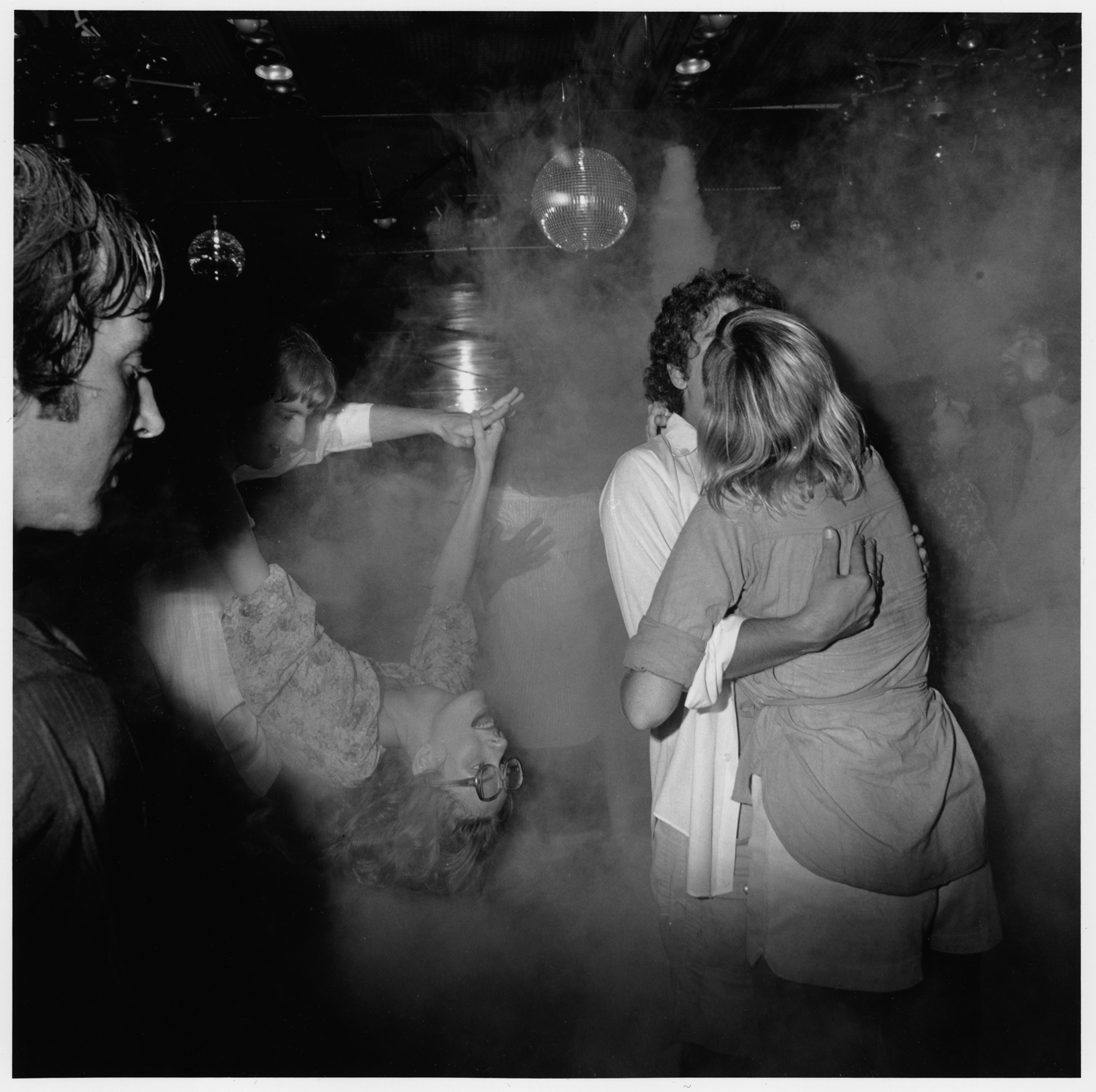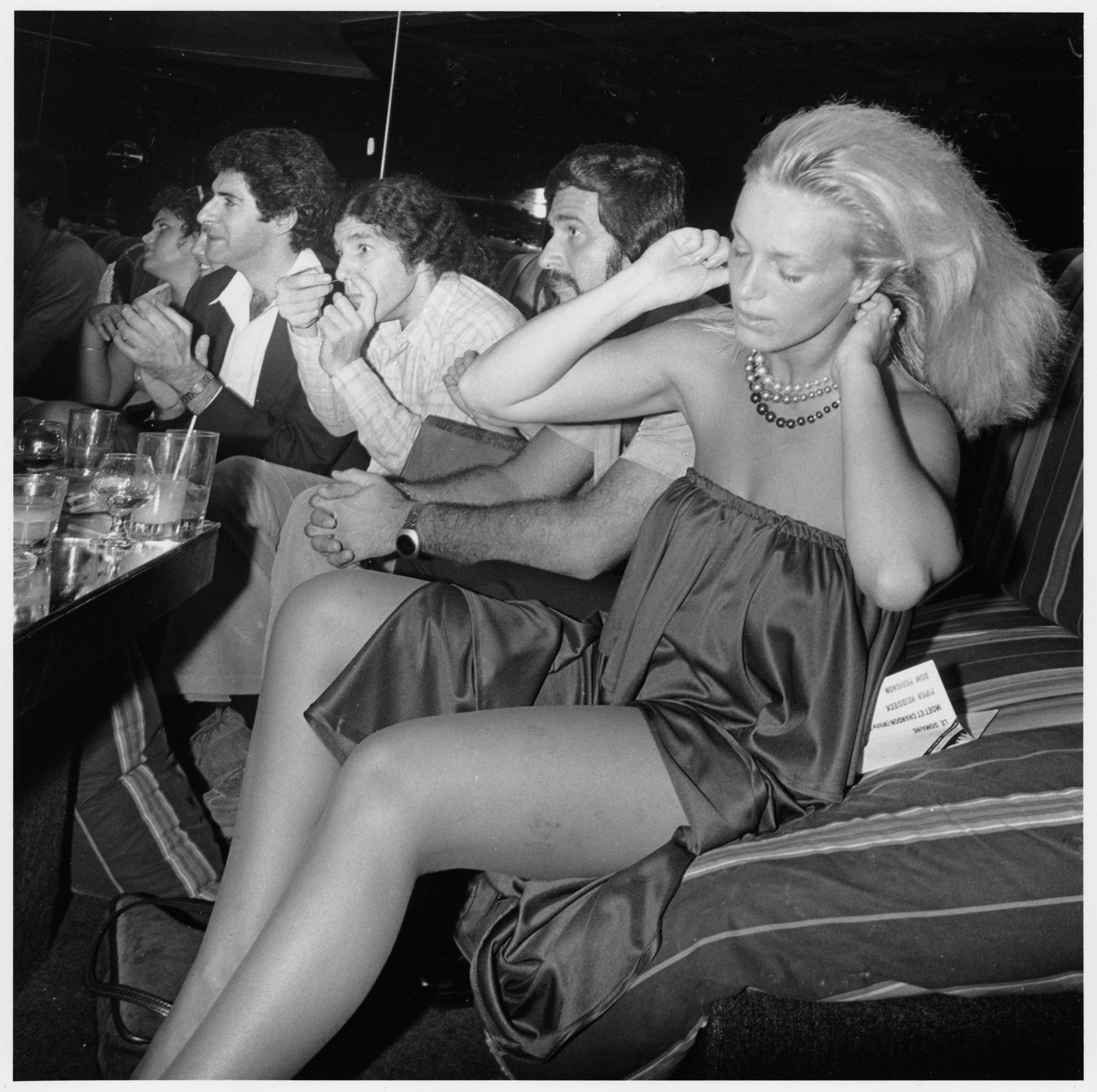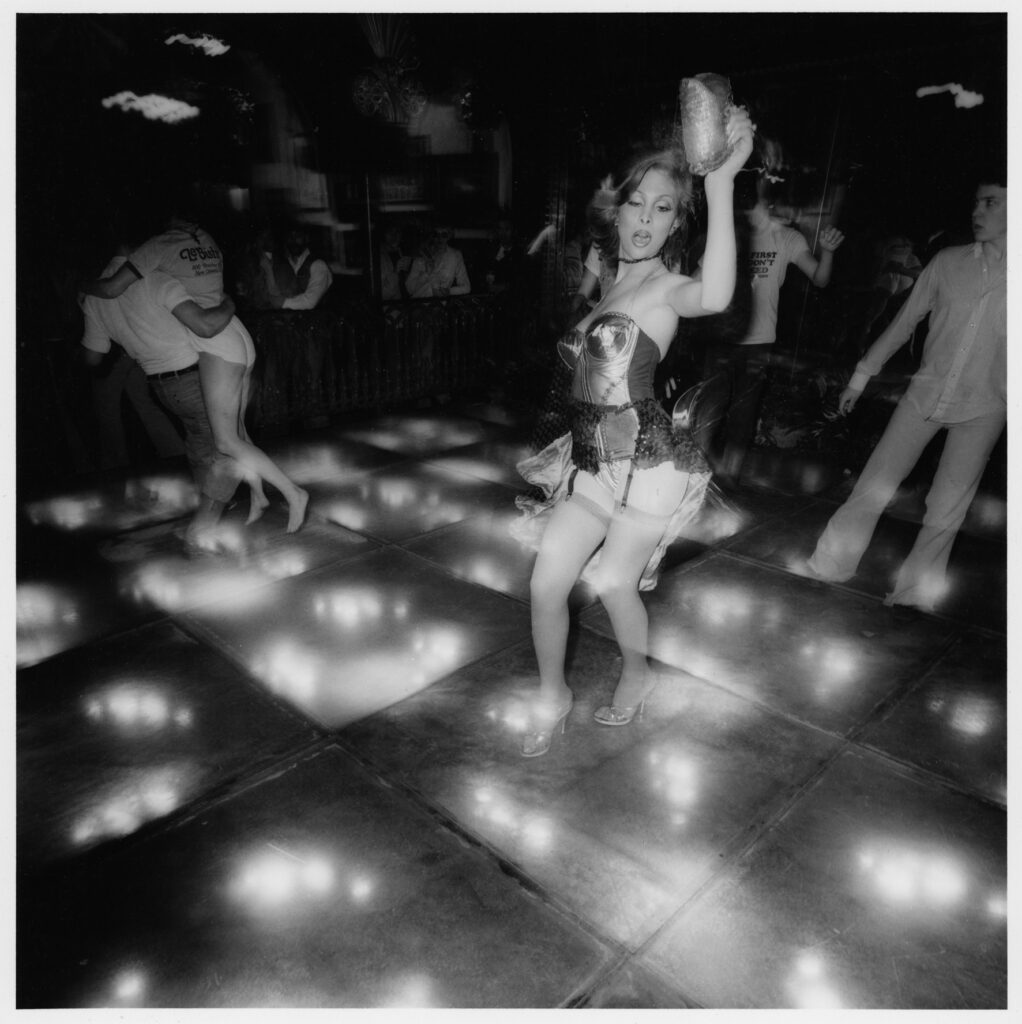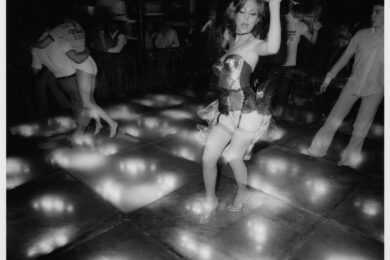The Men In The Glass Booth
===============================
From After Dark, November 1976
He’s there each night from ten to closing time,
With sights and sounds to help the crowds unwind,
And from the booth each night he blows your mind
With his mix and tricks
Forget – for the moment at least – Donna Summer, Silver Convention, Brass Construction, Gloria Gaynor, Bohannon, Love Unlimited – that endless ever-changing, slippery starstream of names shooting through disco heaven. The real stars of the seventies disco boom aren’t on records, they’re spinning them.
Discotheque DJs are no longer mere human jukeboxes – they’ve become tastemakers, record-breakers (several have received gold records in recognition of their influence on sales), mood magicians, performers with personal styles. The new DJ doesn’t just change records, he creates a “total evening,” a musical “journey,” blending records into “one continuous song, one story.” As Tom Savarese, one of New York’s top DJs puts it, “From the moment I go in there to the moment I leave – that’s my canvas.”
To conjure up this kind of vibrant, volatile aural landscape the DJ has to be part artist (the medium: musical collage), part technician, part crowd psychologist. Some would say a total madmen. You have to know your records inside out, they say: the intros, the fades, the breaks, the changes, then maybe you’ll understand why disco DJs talk about "my music". This intimate knowledge allows them to weave record into record, making one seamless tapestry. Like any artist, a talented DJ develops an individual, idiosyncratic style. One is famous for his drum collages – his hot pulsing evocation of the urban jungle. Another has a trademark sound that’s cool, loose and sweetly ecstatic. Still another will purposely break the floor "like a billiard table", shifting the crowd for a record he feels they should hear, nudging them into unfamiliar music. Others are abrasive or frenzied or cheerfully crowd-pleasing, but they all stamp the music with their personal taste. The best inspire passionately loyal followings that trail them from club to club. (In New York, where discos open and close at the drop of a Thorens tonearm, most experienced DJs can reel off a list of past jobs – Sanctuary, the Haven, Machine I, Machine II, Tambourlaine, Limelight, the Ice Palace, Le Jardin, Make-Believe Ballroom – that reads like an index to the city’s underground high and low life for the past ten years.)
The DJ has to be part artist, part technician, part crowd psychologist. Some would say a total madmen.
But if disco DJing is an art, it’s solidly based on technology – not only on the mastery of elaborate systems of turntables, mixers, speakers, amps, filters, headphones and lightboards but on a sensitivity to the technical pluses and minuses of the records. DJs quickly develop a sharp critical ear for the quality of a mix or a pressing, if only because disco equipment is sure to exaggerate flaws. When record companies realized that a muddy studio mix or a drastically reduced sound level was keeping their records off disco turntables they snapped to with special pressings “For Disco DJs Only,” usually single long tracks on limited edition, high-quality twelve-inch discs. This past spring, a number of companies began commercially marketing these discs – the first new record format in decades – and found them selling briskly to people eager for the same full length and quality they had heard in the clubs. (Appropriately, the first “disco disc” in the stores, Double Exposure’s stunning ‘Ten Percent’, was “disco blended” by New York DJ Walter Gibbons, one of a small but increasing number of spinners crossing over to the production side of the music.) Not only was the disco DJ the impetus behind the creation of the “disco disc” but he was the key factor in the development of the entire specialized disco market that record and equipment manufacturers are now turning into a goldmine.
Another necessary talent of the successful disco DJ is a subtle, spontaneous, sure understanding of crowd control. Even when he’s removed, often elevated above the dance floor, absorbed in the next blend, the next switching of knobs and flashing of lights, the DJ has to be simultaneously on the floor, in the midst of the crowd, anticipating its mood at the same time he’s channeling it. It isn’t a matter of simply playing a hot record. Anyone can do that. The DJ must sense the moment when it will have its greatest impact: when the crowd wants it the most and when they least expect it; when they’ll burst into delirious screams on hearing the first three notes. The DJ has to know how long to run them, when to ease up and smooth out, when to hit a peak and keep pushing, when to slip in something new so they’ll love it and not clear the floor. It’s an intuitive science. David Mancuso, famous for the private disco parties at his Loft in New York, describes his approach this way: “I can’t program myself to what happens because it all gets so spontaneous. I don’t plan it, I don’t feel I have any control over it. I’m only a part of the whole, a part of the dance.”

I Won’t Dance, Don’t Ask Me
================================
From Village Voice April 1976
If there is any common stance among rock critics these days. it’s a shared hostility toward what has become known in the past year as “disco.” The “Death to Disco Shit” editorial in the first issue of Punk magazine put it most blatantly – suggesting that readers commit suicide before exposing themselves to “the epitome of all that’s wrong with Western Civilization” – but the attitude had already been set through countless snide asides in the rock press where disco music was regarded as silly yet somehow subversive drivel worth only a passing sneer.
Since music publishers and record companies have seized upon ready-made disco formulas as a way of recycling old songs (‘Baby Face’, ‘Night and Day’, ‘Exodus’, ‘Volare’, ‘Theme From "A Summer Place”’) and old singers (Al Martino, Frankie Avalon, Bobby Rydell, Monti Rock, Teresa Brewer), a lot of the ridicule is well deserved. Disco, the only major pop trend to hit the music business in years, has been treated like a sell-out line on Seventh Avenue. Cheap knock-offs – “disco versions” often just a step above elevator Muzak – are everywhere. But the rock press’s aversion to disco isn’t restricted to the genre’s formulaic rip-offs; in fact it’s so generalized that it bears closer examination.
Because disco evolved quite naturally out of rhythm & blues and more technically advanced soul, this attitude springs first of all from a widespread critical unease and unfamiliarity with black popular music. There are some exceptions of course – Al Green, Aretha Franklin, Stevie Wonder, Smokey Robinson, or Sly Stone; Millie Jackson, Bobby Womack, or Natalie Cole – but the average rock critic’s taste in black music was fixed in the ’60s with the Motown and Stax/Volt sound, recognizing only modern extensions of those styles – tight, hard-edged, and “black” – as valid. But even those critics with a wide-ranging interest in and sympathy for black music in general tend to view disco as predictable (“It all sounds alike”), alienated from its r&b roots, anonymous, and studio-slick. Dave Marsh’s recent dismissal in Rolling Stone of Dance Your Troubles Away, Archie Bell & the Drells’ total-disco comeback album, is almost a model of the anti-disco stance. Marsh describes the album as “a nearly perfect Philadelphia formula record, executed with neither flaws nor feeling” on which “five of the seven tracks are locked into a mechanical disco beat that won’t quit even when you wish it would.” Of course the “won’t-quit” factor is part of the record’s design, but when he echoes the prevailing notion that studio sophistication has replaced “feeling” in disco records, Marsh just isn’t listening.
White rock critics find disco music banal and false because they don’t partake of the-music’s ritual; they aren’t ready to get down.
Dance Your Troubles Away is, in movie terms, an “entertainment” – an album not just for dancing but about dancing, a celebration of release and shared ecstasy. The message, plain and simple: “Music was designed for the body/It’s the perfect remedy/So if you wanna feel better/Come on out here and get down with me.” But Marsh isn’t ready to get down; even a grudging acknowledgement of several “fine dance cuts” is taken back immediately with the comment that “they aren’t anything more than that.” What more, exactly, do they have to be?
Marsh looks back to the old Archie Bell & the Drells, especially ‘There’s Gonna Be a Showdown’, produced by Kenny Gamble and Leon Huff, who supervised the new album. ‘Showdown’, like ‘Tighten Up’, ‘I Can’t Stop Dancing’, and the group’s other singles from the late ‘60s, is brash, bright, and fun; a perfect pop record, inconsequential and of the moment yet delightful enough to stick and last. What is puzzling here is that Marsh, and nearly every other critic with a fondness for the r&b trivia of the past, fails to see ‘Let’s Groove’ – the most successful of the new Archie Bell cuts – as the exact equivalent of ‘Showdown’ for 1976.
But ‘Let’s Groove’ cuts deeper than early Archie Bell because here he’s captured the mood of a time in which the dance floor has become a focus for the social life and energy of so many of us. Like ‘I Love Music’, ‘Fly, Robin, Fly’, ‘Get Down Tonight’ and Bobby Womack’s ‘Daylight’. ‘Let’s Groove’ is an anthem for the middle ’70s, creating and invoking the sustained, expansive spirit of the Party. “Let the music take your mind/It’ll soothe you every time”: Submerge yourself, “dance your troubles away, “ get down, get higher". Do it any way you wanna. There’s a naive belief here that dancing – the movement, the release, and the utter submission to the power of the music – can cure all ills (not unlike the belief that rock & roll could “set you free”). So maybe it isn’t the music itself but the demands of the music – the pressure of the beat and the lyrics: "dance, dance, dance", "get down, get down" – that arouses critical resistance. Marsh’s review is headlined “Do You Wanna Dance?” and the obvious answer is no. I won’t dance, don’t ask me. This is part of a general refusal to see disco partying as anything but mindless escapism when, in fact, a good case could be made for it as a vital tribal rite, an affirmation of high spirits and shared delight, a coming together to let loose that in no way ignores the problems of everyday life (‘Bad Luck’ was one of the biggest disco records last year), but relieves them. Maybe we need a whole new aesthetics for the disco, one that includes the ritual as well as the music.
The emotion of much recent disco music isn’t the romantic love/lost love of basic soul; instead it’s a kind of joyous, out-of-your-head ecstasy, often explicitly sexual (prime example: Donna Summer’s ‘Love to Love You Baby’ in its full 17-minute version), drawn out over a series of changes designed to prolong, heighten, and vary the mood. Long cuts must be better for dancing, Marsh writes, “because they’re awful to listen to". Several of the Archie Bell cuts (especially ‘Let’s Go Disco’, the only one produced by Gamble & Huff alone) are indefensible in this respect; they do become monotonous, even on the dance floor. But ‘Let’s Groove’ (6:21) and the best extended disco music is texturally rich and inventive – it has to be to keep the dancers not only on their feet but involved and excited.
If nothing else, this is supremely functional music. Disco producers create a structure of repetitive, flowing patterns and peaks, waves that shift, crest, and break, carrying the spirits of the dancers with them. But breaks that cause screams in discos – and if you haven’t heard a roomful of people erupt in spontaneous yells and squeals to a particularly stunning change, you haven’t begun to appreciate the disco phenomenon – slip by unnoticed on the radio (where bite-sized chunks are easier to digest) or on a record player at home (unless you’re ready to dance around the living room). Silver Convention’s ‘Fly, Robin, Fly’, one of last year’s most exhilarating, appealing and off-the-wall disco records, turned into a surprise number-one hit, but a lot of the most advanced, hard-core disco music doesn’t survive translation from the dance floor to the radio.
Disco is the epitome of all that’s wrong with Western Civilization
Although it’s been the main crossover music of the past few years – and the first substantial bridge between white performers and the black audience since jazz-rock – disco music has also begin to draw certain social lines more clearly than before, defining two audiences, each in near-total ignorance of the other’s music save for what gets through on the radio. That this ignorance should be wilfully shared by a large part of the rock press is pretty dismaying, and it suggests not only a critical hardening of the arteries, as John Rockwell wrote in the Times, but a desperate attempt at shoring up the bastions of rock & roll against the first wave of a Third World assault.
Extract from The Disco Files 1973-78: New York’s Underground, Week by Week, by Vince Aletti. Available now from www.djhistory.com, £19.95
Find out more about The Disco Files and download a free sample




